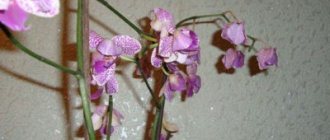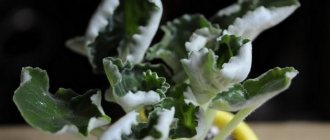How to determine that a flower is sick?
The leaves of the dendrobium have begun to turn yellow - this is the first sign that the plant is not being cared for correctly. In this case , such a phenomenon as curling of leaves and yellowing of the stem often occurs . It is not difficult to determine that an orchid has begun to get sick, since a change in the color of the leaves is immediately visible.
Important! If the leaves turn yellow, the flower needs to be saved, but to do this, it is important to determine why the plant began to hurt. And to prevent this situation from happening again, you need to know the reasons why the orchid begins to turn yellow.
Soft bacterial and brown rot
Erwinia bacteria cause yellowing of the leaves, followed by small wet spots with a yellow edge. These spots later turn black and can cause an unpleasant odor. To stop wilting, it is necessary to remove the affected tissue and treat the plant with a bactericide.
Leaf damage by bitter rot. Photo used as illustration. Source: Yandex.Images
Main reasons
There are several of the most common causes of yellowing of dendrobium leaves - high temperature, disturbance or rotting of roots, low air humidity, overfeeding. There is no need to panic if the leaves turn yellow and begin to fall off after flowering, since this is a natural phenomenon for the Dendrobium Nobile orchid, but if this happened before or during flowering, then you should pay close attention to this.
Despite the fact, growing an orchid is a troublesome task, but in gratitude you can get a magnificent flower with unusual buds. It is worth knowing that each individual type of orchid has its own characteristics in care .
There are six groups into which dendrobiums are divided, and each has specific requirements for indoor air temperature. Therefore, to avoid yellowing of the foliage, you need to create an optimal room temperature for the plant. There are dendrobiums that are heat-loving, and there are those that need to be kept in a cool environment.
For heat-loving varieties, the temperature considered comfortable is:
- period of active development and growth during the day +20-25 degrees;
- at night 16-21 degrees plus;
- during the rest period - in winter, during the day no more than +20 degrees;
- at night no less than +18.
Cool-loving plants:
- in summer, daytime 16-18°C;
- at night about 12°C;
- on winter days about 12°C;
- winter nights 8°C.
The leaves may turn yellow due to rotting of the roots . As is known in nature, orchids live on tree trunks, so the root system of the flower is free from soil. Even after heavy rains they dry very quickly. Therefore, at home, you should avoid dampness in the substrate. Sometimes the cause of yellowing is the age of the plant.
Even if the orchid was purchased recently, there is no guarantee that it has not been in the store for a long time. Despite the fact that dendrobium is a tropical plant, it does not tolerate direct sunlight. On hot sunny days, the orchid needs to be shaded, otherwise a burn may appear on the leaves and they will turn yellow.
Pests and insects cause diseases and yellowing of foliage. An orchid can be attacked by thrips, aphids, and slugs, which can grow not only on the stem, but also on the roots.
Important! Lack of moisture also causes yellowing of foliage. Orchid requires timely and stable watering.
Lighting
Very bright direct sunlight can burn the leaves and cause severe dehydration of the Orchid, dealing several blows to the health of the flower, quickly drying out yellowed leaves . You can place the flower in direct sunlight early in the morning, but it is better to use curtains to diffuse the too bright rays.
Sick leaf. Photo used as illustration. Source: Yandex.Images
Why are changes happening?
Most of them are associated with improper care of the crop, so to maintain the health of the plant, you need to determine exactly what caused the pathology and review the rules for caring for the flower. There are five common situations in which leaves change color.
Aging
Often an orchid begins to bloom only 2-3 years after planting , by which time the plant has already formed true leaves. The aging process begins to affect the lower part of the plant, that is, those leaves that grew first. At the same time, the flower itself is in a healthy condition and has an attractive appearance and continues to bloom. If the leaves turn yellow during the aging process, then there is no need to worry and do something, the leaf will gradually dry out and fall off.
Excess moisture
Proper watering involves placing the plant pot in a bowl of water. In this case, the pot should be 1/3 immersed in water. Leave the plant in this position for 15 minutes, otherwise the soil will become waterlogged.
If watering is excessive, the following happens: the substrate becomes saturated with moisture and becomes impermeable to air, and the root system begins to become oxygen starved. The result is insufficient nutrition of the flower itself, causing the leaves to begin to turn yellow. It is also worth considering that bacteria and fungi can develop in a moist substrate , which provoke plant disease.
Insufficient watering
Orchid leaves can also turn yellow from lack of moisture; they gradually wither, curl and dry out. It is worth noting that this is a very rare occurrence - usually housewives water the flowers as soon as the top layer of soil dries out. Therefore, before watering the orchid again, make sure that the cause of yellowing is precisely the lack of water. To do this, just take a few pieces of bark from the substrate and evaluate the moisture content. You can also just pick up the pot - if it is light, then the soil is dry.
Sunburn
Often, improper lighting causes yellowing of foliage - this is sunburn. If the plant stands on a western or southern window, then in the summer it will receive direct sunlight, which burns the plates. A distinctive feature of this phenomenon is that not the entire leaf plate turns yellow, but only part of it. You should not remove damaged parts - they can recover or fall off on their own; in extreme cases, you can perform sanitary pruning.
Insects
The ground part of the orchid is very delicate, so various insects and pests often grow on it, which subsequently cause yellowing of the leaf plates.
pests: Let's look at the most common
- Spider mite , which sucks the sap from the plant, causing small yellow dots and thin webs to appear on the stems and leaves. If you notice such signs, immediately isolate the diseased plant from other flowers - the mite spreads very quickly. The leaves of a diseased flower should be washed with a solution of laundry soap.
- Aphids - in this case, the leaf not only turns yellow, but also becomes sticky. Aphids can be removed with a soap solution or sprayed with Fitoverm.
- Scale insects are a pest that is very difficult to remove. As soon as you notice growths on the leaves of the plant, you need to take action. You can use folk recipes: a solution of ammonia or a mixture of vegetable oil and water. But the most effective drug for combating scale insects is Actellik.
Shchitovka
One of the most common pests on Dendrobium leaves is scale insects and false scale insects , which hide on the lower surface of the leaves. With their arrival, small round or ovoid spots of white, brown or dark brown color appear on the leaves. These parasites multiply quickly and can only be controlled with strong insecticides. Most Dendrobium species cannot be preserved in this situation, so they must be destroyed.
What to do if there is no improvement?
If all of the above reasons are eliminated, but the leaves still turn yellow, then the flower’s roots may have begun to rot. In this case, you need to replant the plant, first wash the root system in a weak solution of potassium permanganate, dry it and trim off all damaged areas. Then sprinkle the sections with ash or activated carbon and plant them in a new, disinfected substrate.
There can be many reasons for the yellowing of an orchid's leaves, and you need to try all the ways and methods to save this beautiful exotic plant.
Natural aging
This tropical beauty can be found very often both at home and in the office. Sometimes, when cultivated, the leaves turn yellow.
Orchid leaves may turn yellow due to natural aging.
If the flower is not infected with the disease and there is no mechanical damage, the cause may be natural aging of the leaf. These include the Dendrobium orchid.
How does it manifest?
With natural aging, the leaves turn yellow in the lower tier of the bush. Usually this is the very first leaf with which the bush was planted in a separate container when it was still a child. If everything is fine with the rest, they are green and shiny, then this should not cause concern to the gardener. It is worth noting that the leaf changes its color slowly; this period can last up to a month.
IMPORTANT! At this point, you just need to monitor the bush so that this yellowing is not a sign of infection with the disease.
How many years does the average orchid leaf live?
If we consider that an orchid lives on average about 7 years at home, then a leaf can last no more than 6 years with proper care. Sometimes they die earlier, for example, when transplanting, the bush takes nutrients from the leaf for adaptation.
Influence of species on lifespan
This information is conditional, since there is no research on this topic, and all information is based on messages from various forums:
- Paphiopedilum – 150 years;
- Dendrobium – 20 years;
- Cattleya - 18 years old;
- Maxillaria – 13 years.
All these plants grew at home and were well maintained.
If leaf wilting is due to natural aging, then there is no need to panic. The plant itself will gradually turn yellow, the leaf will dry out and fall off.
Urgent help
What to do if the orchid’s leaves turn yellow:
- If burns appear on the leaves, you should immediately move the plant to a shaded place. It is advisable to provide bright but diffused light without direct sunlight. There is no need to remove damaged leaves; with minor damage, the plant will recover on its own.
- A common cause of yellowing leaves is insect larvae sucking juices from the fleshy parts of the plant. They can be found on the underside of the leaf. Wash off the pests with a warm soapy solution, wiping the leaves, petioles and leaf axils with a damp cotton swab. In this case, the ground must be covered with film or foil. Treatment is repeated for 2–3 weeks until the parasites completely disappear.
- If the tips of the leaves of a flower turn yellow and dry, the cause may be overfeeding with mineral fertilizers with potassium. The plant must be removed from the pot, the roots washed with warm, settled water, and then moved to a container with fresh substrate. The best choice is a special soil for orchids. After transplantation, you can feed the orchid only after a month.
- With insufficient watering, the leaves dry out, become brownish-yellow and quickly fall off. To save an orchid, you need to place the pot in water. When the earthen lump is completely saturated with moisture, the orchid is taken out, and after a day the procedure must be repeated. It is advisable to check the condition of the drainage: a layer that is too thick quickly removes moisture, preventing it from penetrating to the roots.
The lower leaves have turned yellow
Changing the color of the lower leaves is a natural process. Old shoots gradually die off, and new ones take their place. There is no need to try to tear off leaves that have lost their beautiful appearance as soon as possible, as this can injure the stem. It is better to wait until the old leaf withers on its own, after which it can be removed.
The stem turns yellow: what to do
The orchid stem may turn yellow due to mechanical damage. As a result, the growing point shifts, part of the stem turns pale, then dries out and gradually dies. This can be avoided if you treat the injured plant with an antiseptic and provide it with comfortable conditions: moderate heat, proper watering, bright but diffused light.
Orchid got sick after transplant
Transplantation is stressful for any plant, and many types of orchids react especially sensitively to this procedure. A plant grown in greenhouse conditions responds painfully to too dry air and an incorrectly selected substrate.
It is very important to choose a pot of the right size. For successful development and flowering, an orchid needs close quarters, otherwise the roots will begin to grow rapidly to the detriment of the formation of buds. The ideal diameter of the pot exceeds the volume of the root ball by no more than 5 cm
It is advisable to choose a transparent plastic container, it will allow you to monitor the condition of the earthen clod
The ideal diameter of the pot exceeds the volume of the root ball by no more than 5 cm. It is advisable to choose a transparent plastic container, it will allow you to control the condition of the earthen ball.
Yellowing leaves on an orchid do not always indicate serious problems. Urgent measures need to be taken if most of the greenery changes color and the leaves dry out and fall off. Making adjustments to the care program will help save the plant and restore its attractive appearance.
The tips of the leaves of the dendrobium orchid turn yellow
Yellowing of the tips of the shoots is not observed so often. This color change is observed when there is an excess of sunlight or calcium in the substrate. If you do not make adjustments to the crop's nutrition and do not adjust the lighting, over time the entire shoot becomes yellow. Dendrobium is very susceptible to both lack of nutrition and an excess of microelements in the soil. It is extremely dangerous to overfeed a flower at an early stage of development.
The crop is mainly purchased in flower shops, where sellers, in order to prolong bright and dense flowering, saturate the substrate with various growth stimulants and fertilizers. After a couple of years of such existence, such bushes become depleted and die. In this regard, it is not recommended to feed a freshly purchased plant. And after maintaining the quarantine period, it is worth replanting the new flower into a fresh substrate and a new container.
Recently, an equally common problem why a leaf changes its color is the excess amount of calcium in the substrate. This is caused by soil salinity, which prevents the crop from absorbing iron. In this case, the system of supply of mineral components is completely disrupted. The shoots become dull, the tips turn yellow and curl. The edges of the platinum become torn. Young shoots react especially strongly to this. In such a situation, it is necessary to save the flower - urgently replant it by washing the roots under running water.
Advice! Until the bush is completely restored, it is recommended to exclude any additional feeding with calcium-containing complexes.
Low air humidity also causes the edges of the sheet platinum to dry out.
It is important to remember that the natural climate of orchids is famous for high air humidity, and the dry climate of an apartment will destroy the delicate plant. In rooms with dry air, the crop always begins to dry out from the tips of the leaves
Using a humidifier or irrigating the bush with a spray bottle will help restore vitality and attractive appearance to the plant.











